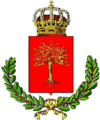Bisceglie
| Bisceglie | ||
|---|---|---|
| Comune | ||
| Comune di Bisceglie | ||
|
The harbour | ||
| ||
 Bisceglie Location of Bisceglie in Italy | ||
| Coordinates: 41°14′35″N 16°30′19″E / 41.24306°N 16.50528°E | ||
| Country | Italy | |
| Region |
| |
| Province / Metropolitan city | Barletta-Andria-Trani (BT) | |
| Government | ||
| • Mayor | Francesco Carlo Spina (Scelta Civica) | |
| Area | ||
| • Total | 68.48 km2 (26.44 sq mi) | |
| Elevation | 16 m (52 ft) | |
| Population (1 January 2014)[1] | ||
| • Total | 55,424 | |
| • Density | 810/km2 (2,100/sq mi) | |
| Demonym(s) | Biscegliesi | |
| Time zone | CET (UTC+1) | |
| • Summer (DST) | CEST (UTC+2) | |
| Postal code | 76011 | |
| Dialing code | 080 | |
| Patron saint | Sts. Maurus, Sergius and Pantaleon[2] | |
| Saint day | First Monday in August | |
| Website | Official website | |
Bisceglie (Italian pronunciation: [biʃˈʃeʎʎe]) is a town and comune on the Adriatic Sea, with a population of c. 55,424, in the province of Barletta-Andria-Trani, Apulia (Italian: Puglia), in southern Italy.
History
According to one theory, in Roman times there would have been a settlement here called Vigiliae (Vigil). The modern city was founded by the Normans in the 11th century and enlarged under the Aragonese dynasty of Naples in the 15th century.
Ecclesiastical history
Around 800 AD was established a Diocese of Bisceglie.
It was suppressed on 27 June 1818, its territory and title being merged into the Metropolitan Archdiocese of Trani-Bisceglie.[3][4]
Bishops
(?incomplete: first centuries unavailable?)
Suffragan Bishops of Bisceglie
- Apostolic Administrator (1280.04.01 – 1288.06.04) Opizzino Fieschi
- Leone di Gaeta (1303? – ?)
- Giovanni (1314? – ?)
- Giacomo (1317? – ?)
- Nicola (1320? – ?)
- Bartolomeo Fiore, Dominican Order (O.P.) (1327? – ?)
- Martino Sambiasi (? – death 1348)
- Simone de Rayano (1348.11.05 – death 1367?)
- Nicola Ricci, Friars Minor (O.F.M.) uncanonical (1387.07.19 – 1421.04.21, without papal mandate); later canonical Bishop of Krk (Croatia) (1421.04.21 – 1435)
- Domenico (? – ?)
- Giovanni (1390? – 1390)
- Giacomo Federici, Carmelites (O. Carm.) (1391.01.04 – 1399?)
- Francesco Falconi (1399? – ?)
- Nicola Falconi (1413 – death 1442)
- Pietro de Gravina (1442.05.23 – death 1476)
- Bernardino Barbiani (1476.08.09 – 1487.08.24), later Bishop of B* (Italy) (1487.08.24 – death in ?)
- Martino Madio da Tramonti (1487.08.24 – death 1507), previously Bishop of Bisaccia (Italy) (1463.04.08 – 1487.08.24)
- Antonio Lupicino (1507.11.19 – 1524)
- Geronimo Sifola (1524.05.11 – death 1565)
- Bartolomeo Serristori (1551.07.03 – death 1555)
- Giovanni Andrea Signati (1565.08.22 – 1575.09.23), later Bishop of Bisignano (Italy) (1575.09.23 – 1575.11)
- Leonardo Bonaccorsi (1575.09.23 – death 1576)
- Giovanni Battista Soriani, O. Carm. (1576.08.22 – death 1582.06.25)[5]
- Nicola Secadenari (1583 – death 1583.07.30)
- Alessandro Cospi (1583.10.07 – death 1609.05.15)
- Antonio Albergati (1609.08.03 – 1627)[6]
- Nicola Bellolatto (1627.03.08 – death 1636.07.15)
- Bernardino Scala (1637.01.12 – 1643.05.28), later Bishop of Montefeltro (Italy) (1643.05.28 – death 1667.01.19)
- Guglielmo Gaddi (1643.08.31 – death 1652.02.07)
- Giuseppe Lomellini, Benedictines (O.S.B.) (1652.08.26 – death 1657.08.25)
- Cesare Cancellotti (1658.04.01 – 1662.06.16), later Bishop of Montalto (Italy) (1662.06.16 – death 1673.06.27)
- Giovanni Battista Penna, Augustinians (O.E.S.A.) (1663.04.09 – death 1664.07.02)
- Francesco Antonio Ricci, Observant Friars Minor O.F.M. Obs. (1664.09.15 – death 1685.04.28)
- Giuseppe Crispino (1685.09.10 – death 1690.11.13)
- Pompeo Sarnelli (1692.02.17 – death 1724.07.07)
- Antonio Pacicco, O.F.M. (1724.09.11 – death 1739.03)
- Francesco Antonio de Leonardis (1739.07.15 – death 1762), previously Bishop of Trevico (1733.05.11 – 1739.07.15)
- Antonio Giannelli (1762.11.22 – death 1783)
- Salvatore Palica, Celestines O.S.B. Cel. (1792.03.26 – 1800)
Main sights
- Cathedral (13th century)
- Church of Santa Margherita, in Romanesque-Apulian style (12th century), with fine canopied tombs of the Falcone family[7]
- Norman castle and tower
- Abbey of S. Adoeno (11th century)
- grottoes of Santa Croce
- 4 dolmens
Also notable is the naturalistic area of Pantano-Ripalta.
Twin towns — Sister cities
Bisceglie is twinned with :
-
 San Pancrazio Salentino, Italy
San Pancrazio Salentino, Italy -
 Fuheis, Jordan
Fuheis, Jordan -
 Khan Yunis, Palestine
Khan Yunis, Palestine -
 Tartus, Syria
Tartus, Syria -
 Kalwaria Zebrzydowska, Poland
Kalwaria Zebrzydowska, Poland
Notable people
- Louis I, Duke of Anjou died there in 1384
- Cesare Fracanzano (1605–51) tenebrist painter
- Gaetano Veneziano (1665–1716) baroque composer
- Mauro Giuliani (1781–1829) guitar virtuoso and composer
- Leonardo de Mango (1843–1930) orientalist painter
- Mauro Cozzoli (1946), theologian and writer
- Erica Mou (1990) pop-singer and musician
- Nancy Dell'Olio (1961) lawyer
Transport
Bisceglie railway station links the town with cities such as Rome, Bologna, Ancona, Foggia, Bari, Lecce and Taranto.
Neighbouring communes
Corato, Molfetta, Ruvo di Puglia, Terlizzi, Trani, Andria
Sources and External links
Notes
- ↑ Population data from Istat
- ↑ Source for patrons: http://www.comuni-italiani.it/072/009/index.html
- ↑ "Diocese of Bisceglie"Catholic-Hierarchy.org. David M. Cheney. Retrieved October 7, 2016
- ↑ "Diocese of Bisceglie" GCatholic.org. Gabriel Chow. Retrieved October 7, 2016
- ↑ "Bishop Giovanni Battista Soriani, O. Carm." Catholic-Hierarchy.org. David M. Cheney. Retrieved March 21, 2016
- ↑ "Archbishop Antonio Albergati" Catholic-Hierarchy.org. David M. Cheney. Retrieved November 24, 2016
- ↑
 Chisholm, Hugh, ed. (1911). "Bisceglie". Encyclopædia Britannica. 3 (11th ed.). Cambridge University Press. p. 992.
Chisholm, Hugh, ed. (1911). "Bisceglie". Encyclopædia Britannica. 3 (11th ed.). Cambridge University Press. p. 992.

